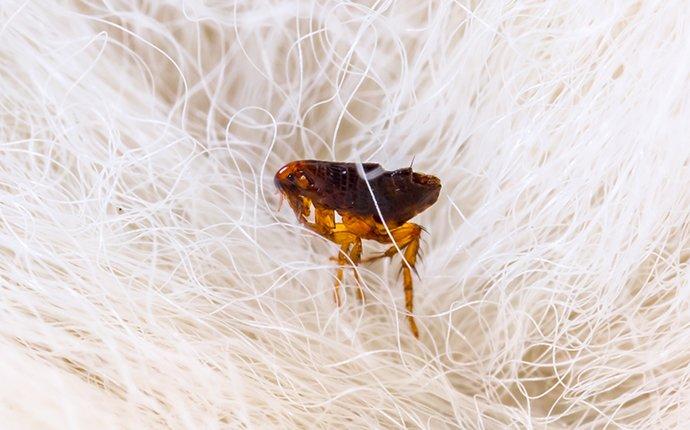Fleas are tiny parasitic pests that depend on the blood of a host to survive. While these small insects do bite humans, fleas can’t live on us. Instead, they prefer animals with thick fur in which to hide. Dogs, cats, and wildlife are the most common hosts for fleas.
Signs you should be on the lookout for to determine if your pet has fleas include:
- Red, inflamed patches of skin. Some pets are allergic to flea saliva and may exhibit rashes and lesions on their bodies.
- Excessive scratching. Pets with fleas will scratch, lick, or bite at their skin more often than usual.
- Hair loss. Excessive scratching often leads to bald patches and hair loss, which can be harmful to your pet.
- Flea “dirt” on your pet’s skin. If you spot small black or dark red specks in your pet’s fur, you’re probably looking at flea “dirt” or excrement.
Pets can pick up fleas while outdoors, on walks, or by coming into contact with an animal that already has fleas.
Are Fleas Dangerous?
While pets are the primary target for fleas, they will still often bite humans—opening up both you and your pet to the chance of contracting harmful diseases and health problems. In cases of prolonged, severe flea exposure, pets may have several bald patches, irritated skin, or even anemia. Anemia is a condition in which there aren’t enough healthy red blood cells to carry oxygen to muscles and body tissues. Pets with anemia may appear tired and weak and have pale gums. Some of the diseases fleas are known for transmitting include murine typhus, tularemia, and many others.
If DIY Doesn’t Cut It, What Does?
There are many natural gimmicks and DIY tips online; however, they are never as effective as professional flea control. Some homeowners may try placing a dish of soapy water under a lamp, while others use flea “bombs.” Unfortunately, both these methods are ultimately unsuccessful against flea infestations. DIY flea control methods are pretty much a waste of time, money, and extra frustration. In a single year, you could spend over $100 on DIY flea products that don’t work.
The best way to eliminate, control, and prevent flea infestations is by making a collaborated effort with your vet and a pest control professional. Veterinarians can provide your pet with an approved and effective flea collar, while a pest professional can reduce flea populations around your Texas home. Romney Pest Control provides effective flea control and removal services for San Antonio properties. Reach out to us today to learn more about our flea control programs. We are always ready to assist you with your pest control needs!




